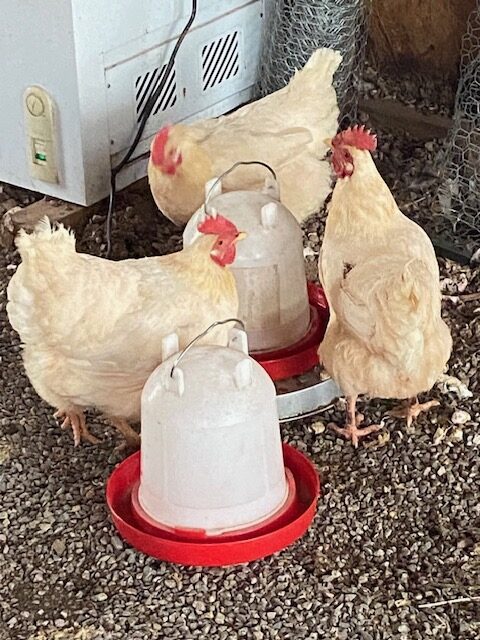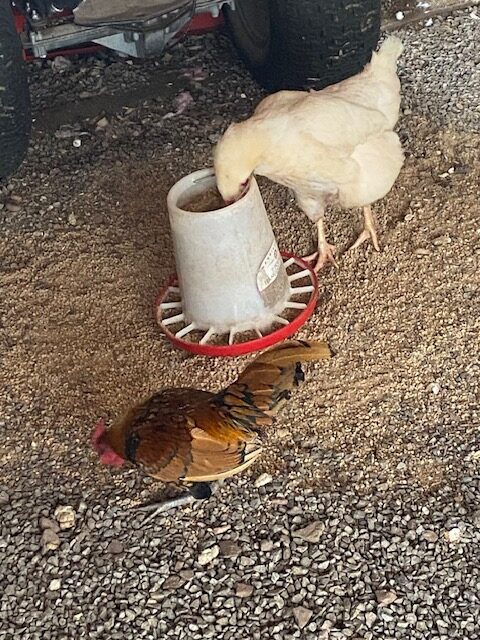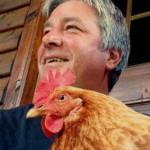

Chickens use various actions and signals, such as body posture or vocal sounds, to communicate with each other and with you. From a relaxed cluck to a pronounced squawk, every behavior has a clue behind it.
Understanding chicken body language gives us some insight into how they communicate. Chickens don’t just cluck, crow, peck, and scratch randomly.
Once you crack the code, their hidden language can tell you loads about their needs, moods, and even the social dynamics within your flock.
Watching their behavior reveals a lot about their happiness and health. This keen observation will yield well-understood, peaceful, productive chickens and alert you early on to health issues or environmental stress.
Chickens use various actions and signals, like body posture or vocal sounds, to talk to each other and you. From a relaxed cluck to a pronounced squawk, every behavior has a clue behind it.
Get to know these signs, and you’ll start noticing what they’re really trying to say—whether they’re feeling content, under threat, or just craving a dust bath in the sun.
Why Chicken Body Language Matters
Monitoring your feathered flock closely through their body language gives you a heads-up for their health and wellness.
Chickens can be masters of disguise when showing signs of illness—they won’t wear a “sick” badge. Instead, subtle changes in their behavior can clue you into potential health issues before they become big problems.
Some signs are:
- Lethargy – Hangs with the crowd but is slow and lags behind.
- Self Isolation – You find them in the coop alone while others are out and about or wedged in a corner, if not free-ranging
- Droopy Head – Like they’re looking at the ground. Eyes may not be as wide as usual.
- Quiet, not as vocal as usual.
Understanding chicken behavior helps spot health problems early and offers an insightful peek into the flock’s social dynamics. Have you ever wondered who the boss in the yard is? Observing their pecking order can tell you a lot.
The top of the order gets first dibs on food, the roosting area, and the nesting box. If necessary, roosters posture and fight, sometimes to the death, to determine leadership.
The way they interact with each other shows their rank within the group and can highlight any bullying or stress that might be upsetting the harmony.
Not all bullying is actual bullying. Sometimes, if a chicken gets a slight injury, others will instinctively gang up on the wounded chicken, especially if there is a blood spot to target.
After removing the injured chicken and letting it heal, it can often be inserted back into the flock and returned to its previous place in the pecking order.
This thoughtful observation doesn’t just prepare you for trouble; it helps you foster a peaceful, cohesive environment where chickens can thrive.
By tuning into their signals, you’ll create a balanced habitat where each bird can feel secure just being itself.
Decoding Chicken Signals



The gallery photo above was taken during a thirty-second period on the morning of this writing. The signals are clear, and peace reigns over the kingdom.
Chickens use subtle signals and actions that, once decoded, can tell you a whole lot about their state of mind and well-being. Let’s break down some common behaviors so you can become a pro at reading your flock.
When your chickens are happy and content, they show it through relaxed clucking, pecking and scratching, indulging in dust baths, and soaking up the sun.
These behaviors say ‘all’s good’ in their world—no stress, just happy hens enjoying life.
But what about when things aren’t so rosy?
Chickens on edge will:
- Start making loud squawks, crouching down low
- Clucking rapidly as a group and cocking their heads, looking all around for the problem they know is there but can’t see (like a fox circling the yard).
- Tighten up their grouping and nervously pace.
These actions often signal distress due to predators, bullying by other chickens, or environmental stressors like overcrowding or sudden changes in their setup.
And then there’s the dramatic side of chickens—those aggressive or dominant moves. Raised hackles, chest bumping, or little squabbles are their way of settling ‘who’s the boss’ disputes or competing for resources.
Lastly, hens’ broody characteristics can be utterly charming yet slightly territorial.
Growing ‘mom instincts’ can cause them to puff up their feathers, stay glued to the nesting box, or even let out a growl to protect their unborn chicks. Recognizing this behavior indicates it’s nesting time and helps you provide the needed support.
Try to reach under a broody hen, and you will probably find out what it is like to be pecked, which is not bad because it makes you realize how powerful their pecks are to other chickens.
You might say, “Aww, that’s nothin’,” but to a little hen or poult, OUCH!! That Hurts!
Understanding Chicken Vocalizations

My Bantam Rooster Letting the Universe Know He’s Here
Chickens are more than their funny struts and fluffy feathers. Their vocal cords have quite the repertoire vital in revealing what’s going on in those little bird brains.
From soothing coos to loud squawks, understanding these sounds opens up a new way of interpreting their needs and feelings.
Chickens use clucks and crows to say a lot without words. A gentle cluck during feeding time is often about good vibes—they’re content and enjoying their feed.
You might notice the tone changes when something unexpected pops up in their environment, like when your dog enters their territory or when they’re startled.
They’re called “chicken” for a reason, you know.
Ever heard the morning crow? Roosters aren’t just blaring about the dawn; those crows speak of territorial announcements or even sometimes alert the flock to potential threats.
In contrast, hens might use a softer, more consistent clucking pattern to call their chicks or signal the discovery of some delicious morsels.
When the volume cranks up, it’s a stress alert. Loud, high-pitched squawks can indicate fear or discomfort. Whether it’s looming predators, a love-crazed rooster (all day, every day!), a missing companion, or just the surprise garden hose, recognizing these vocal signals helps you respond quickly and appropriately to alleviate stress and restore calm.
Knowing these vocal clues makes it easier to keep your chickens comfortable and happy and gives you peace of mind, knowing you can respond to their calls effectively and on time.
Body Posture and Motion – The Chicken Dance
Chickens’ movements and postures contain an unspoken language. Watching how they carry themselves can tell a whole narrative about their mood and social interactions.
When chickens spread their wings wide, they’re not always flapping for fun. Wing spreading is often used to communicate dominance or even challenge another bird. It can also be a cooling-off mechanism during hot days—so context is key here.
If you’ve ever noticed a chicken strutting around with its head hilariously bobbing, you’re glimpsing a bit of its navigational skill in action. This head bob isn’t just quirky; it’s part of how chickens see the world, stabilizing their field of vision as they move.
They see all – up, down, and all around. They have to keep their eyes on the sky for hawks, the brush for the fox, and the ground for food. So, you see, all that silly bobbing serves a purpose.
Tail positioning also sends clear messages. A raised tail can signal confidence or alertness, whereas a droopy tail might indicate discomfort or illness. Keep an eye out for when tails droop—it’s often a chicken’s way of saying, ‘I’m not feeling so hot.‘
Deciphering these movements helps you understand what’s normal and spot anything off-peak fast.
Creating a Stress-Free Environment for Your Flock
Ensuring your chickens live in a serene and comfortable environment is key to unlocking their chattiest, happiest selves. Many factors silently influence your flock’s behavior, from the weather to the space they have to roam.
Weather deserves a special mention because it dramatically influences chicken behavior. On extremely hot days, you might notice your chickens panting or holding their wings out to cool down.
They will be lethargic on these days. Are they ill? No, they are simply trying to stay cool. Providing shaded areas and ensuring they have enough water helps them manage this heat stress.
As a rule of thumb, they drink about twice as much in the summer as in winter.
Space is necessary. Crowding can ramp up aggression and stress levels. Providing ample room for each chicken to have personal space and plenty of room to socialize helps minimize tension. That way, they’ll be less likely to squabble over territory or food.
A well-structured environment also includes the right kind of noise. Loud noises make chickens jumpy—instead, keep their space calm and peaceful. If you’re setting up a coop, consider the traffic flow around the area to minimize disturbances.
My coop is behind my house, away from the road. Although they still find the road when free-ranging, the sound of traffic doesn’t make them feel ill at ease at night while roosting.

Lastly, focus on flock size. Managing the number of birds ensures everyone has access to key resources, promoting harmony and reducing the pressure that often leads to pecking order disputes.
By tweaking these environmental elements, you’ll understand chicken body language better and contribute to a home where they’re stress-free and thriving.
Dave

Chickenmethod.com
…
https://chickenmethod.com/understanding-chicken-body-language-what-do-their-actions-mean/
chickenmethod.com
Feed Name : Chicken Method
Chicken Health,Helpful Chicken Articles
hashtags : #Understanding #Chicken #Body #Language #Actions






Leave A Comment